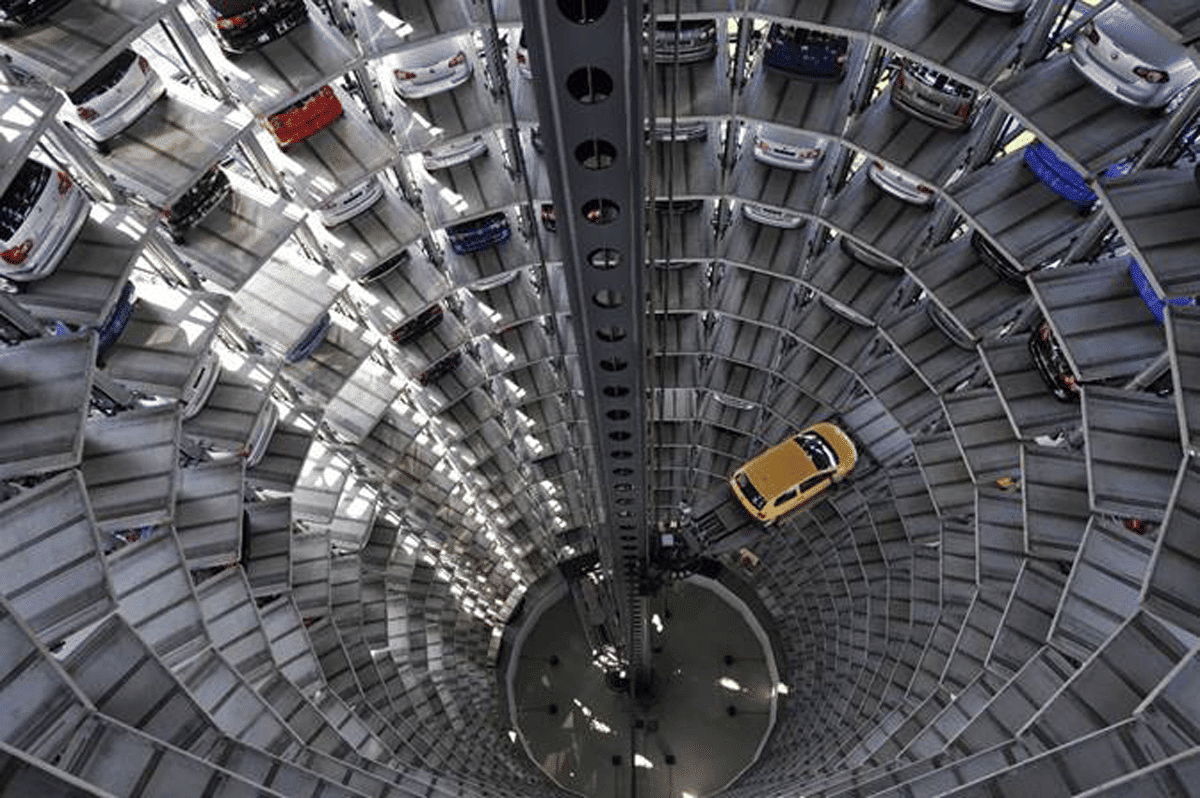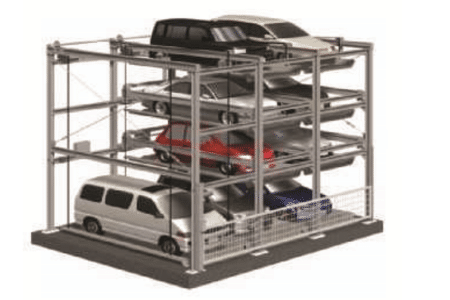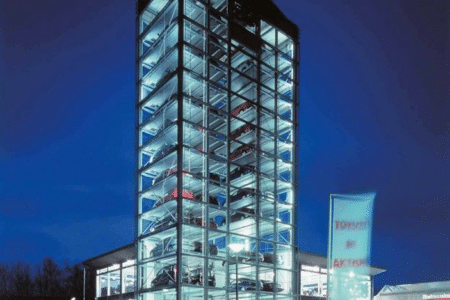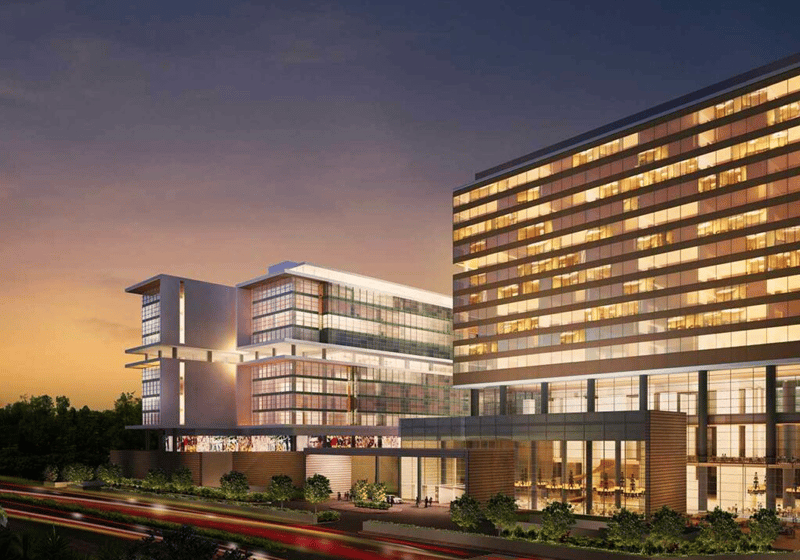Urban Growth Fuels Need for Parking Systems
Jun 3, 2021

Space-saving designs allow more cars to be used in tighter areas.
The world is undergoing the largest wave of urban growth in its history. According to the United Nations, more than half of the world’s population resides in towns and cities, and by 2030, this number is expected to swell to almost 5 billion. More and more people are living in highly urbanized regions, and many have the desire and means to drive their own automobiles. As a result, parking places have become a scarce commodity as values rise in densely populated cities.
As long as there have been automobiles, people have considered technical installations that make it possible to park more vehicles in a given space. Developments seen from a historical perspective make the use of different technologies evident. The essence of these mechanical parking systems is that a mechanical conveyor system takes care of at least a part of the transportation of the vehicle from the entrance of the parking facility to the parking place and back. This can be accomplished in either fully automatic or semi-automatic systems.
Of all the challenges, price remains a deterrent. It is very important that manufacturers adopt a more sustainable and cost-effective approach toward their products, which would allow a user-centric purchase, rather than a purchase to meet regulatory requirements. In India, the concept of automated parking is still restricted to larger cities.
In fully automatic facilities, no people are inside the vehicle or controlling the system during the transport. The installation operation is computer controlled, unmanned and completely automatic. The car is handed over to the parking system at the transfer cabin. The driver exits the car and instructs the system to park the car, which is secured and handed over to the system. The main gate closes, and a conveyor takes the car to a parking place. When ready for his or her car, the user request the vehicle, which is automatically returned.
In semi-automatic facilities, the user drives the car onto a platform and parks. The car is then either lifted or slid on the platform and placed in an available parking slot. This allows the parking lot to double or triple capacity while the general layout of the facility remains similar to a conventional situation. Car elevators allow the use of more space by eliminating driver ramps.
History
The oldest mention of a mechanical parking system your author has found is the Garage Rue de Ponthieu in Paris, designed by Architect Auguste Perret. The system was built in 1905 and moved vehicles to the first or second floor, where they were parked by an attendant. Although this was basically a semi-automatic system, the layout is still surprisingly common in modern parking systems. In the 1920s, parking systems were built throughout the U.S., especially in cities like NYC, Chicago and Los Angeles. They were mainly paternoster-type tower layouts.
This indicates a range will follow. Up to the late 1950s, particularly the so-called “pigeon hole”-type parking system by Pigeon Parking Hole Corp., more than 70 systems were built in the U.S. A central elevator with an operator, capable of moving sideways through a corridor, parked the cars to either side. Also, the less-automatic systems designed by Richard Bowser entered the market in 1953, and these systems gained a substantial market share. Many operated for more than 20 years, but ever-increasing land prices, mechanical problems and high maintenance costs led to their demolition.
From the 1970s, more technically advanced systems were developed and built throughout Europe, Asia and Central America. Mechanical parking systems took off in Japan, stimulated by government tax laws promoting commercial parking facilities. The paternoster-type systems are common here, and annual production has been growing steadily to some 40,000 automatic parking places annually. Other types, such as the shuttle tower and the simpler, two-layered semi-automatic system, have gained more popularity. Total annual production in the late 1990s was well over 100,000 automatic parking places per year.
In Europe, mechanical parking has been gaining significant popularity more or less since the 1980s. With production focused in Germany and Italy, annual output has been steadily growing. Technology has improved dramatically, leading to faster, more reliable and user-friendly systems.
The story in India is a bit different. Mechanical parking systems have gained significance only in the past decade or so, with the main reason being the demand for them is a regulatory requirement, rather than for convenience. The cost of a mechanical system is higher, so, to meet regulatory requirements, the choice has often been for dependent systems, rather than independent or automatic systems.
Standards
The volume needed for parking systems depends on the maximum dimensions of the cars. To make a fair comparison, the following dimensions were used:
- Maximum Car Height: 180 cm
- Maximum Car Width: 210 cm
- Maximum Car Length: 510 cm
Fully Automatic Systems
- The necessary available height for one layer is the maximum car height, plus 50 cm for construction and the conveyor system.
Semi-Automatic Parking Systems
- The minimum width of the driveway is considered to be 6 m to make easy access to the platform possible.
- The necessary available height in an area where people walk and drive their cars is considered to be 250 cm, including space for pipes and ducts.
Challenges
Many global projects have been plagued with unacceptable availability, so increasing availability has to remain a focus of all suppliers. Regarding safety, it would be nice if the parking system could detect a person in the car, but there is currently no sensor technology available to do so. Implementing it could greatly improve the safety of fully automatic parking systems. Of all the challenges, price remains a deterrent. It is very important that manufacturers adopt a more sustainable and cost-effective approach toward their products, which would allow a user-centric purchase, rather than a purchase to meet regulatory requirements. In India, the concept of automated parking is still restricted to larger cities.
Problems felt by the industry include the absence of a regulatory body to monitor the quality of such systems, a lack of skilled labor to assemble them and poor aftersales services. Simpler dependent or semi-independent systems, like stackers or puzzle-parking, face their own disadvantages. Generally, only two or three cars can be parked in the space for one. Since this system works on a one-slot-empty basis, to retrieve or park one car means multiple cars must be shifted, which increases the time to retrieve a vehicle. Because of the number of pallets (cars) that have to be moved for parking or retrieving a single car, the number of moving parts increases and, hence, the operation and maintenance expenses increase. The system is also noisy.
Opportunities
- Real estate costs are forcing builders to opt for mechanical parking systems to pack more cars per square foot.
- Space constraints in apartments is another opportunity that has not been tapped. Owners of multiple cars can stack their cars one over the other in the same parking space allotted to them.
- Automatic parking and retrieval systems with multiple entry and exit points offer users a major advantage.
- Paid parking with prepaid cards will encourage people to park their cars in these systems.


Get more of Elevator World. Sign up for our free e-newsletter.






